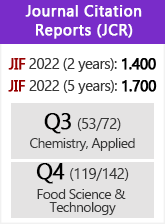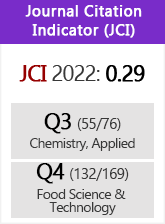Physico-chemical characteristics of seed oils extracted from different apricot (Prunus armeniaca L.) varieties from Pakistan
DOI:
https://doi.org/10.3989/gya.095011Keywords:
Apricot (Prunus armeniaca L.), Fatty acids, Oxidation parameters, TocopherolsAbstract
The fruit seed oils from four varieties of apricot (Prunus armeniaca L.), namely, Halmas, Nari, Travet and Charmagzi were analyzed for different physico-chemical characteristics. The oil yield from the apricot seeds (kernels) ranged from 32.23-42.51%, while the protein, fiber and ash contents ranged from 13.21-20.90%, 5.13-9.81% and 2.11-3.89%, respectively. The extracted oils had an average iodine value (g of I/100 g of oil) of 96.4-106.3; density at 24 °C, 0.87-0.93 mg/mL; refractive index (40 °C), 1.4655-1.4790; saponification value, 189.1-199.4 mg of KOH/g oil; unsaponifiable matter, 0.59-0.88%; free fatty acid (mg of KOH/g oil), 0.41-1.28; and color (1-inch cell), 1.31-2.96R 1 14.8-29.8Y. With regard to the oxidation state, the tested oils showed values for specific extinction at 232 and 268 nm, 2.30-3.42 and 0.82-1.04, respectively, while the peroxide value was 1.0-2.32 meq O2/kg and, p-anisidine was 1.22-1.90. The major fatty acid found in the oils was oleic acid (62.34-80.97%) followed by linoleic (13.13-30.33%), palmitic (3.35-5.93%), linolenic (0.73-1.03%) and stearic (1.10-1.68%) acids. The contents of α-, γ-, and δ-, tocopherols in the oils ranged from 14.8-40.4, 330.8-520.8 and 28.5-60.2 mg/kg, respectively. The results of our present investigation revealed that apricot seed is a potential source of oil which can be used both for edible and oleochemical applications.
Downloads
References
Abdel-Rahman MK. 2011. Can apricot kernels fatty acids delay the atrophied hepatocytes from progression to fibrosis in dimethylnitrosamine (DMN)-induced liver injury in rats. Lipids Health Dis. 10, 114. http://dx.doi.org/10.1186/1476-511X-10-114 PMid:21736706 PMCid:3155902
Adawy El and Taha KM. 2001. Characterization and composition of different seed oils and flours. Food Chem. 74, 47-54. http://dx.doi.org/10.1016/S0308-8146(00)00337-X
Adhikari P. Hwang KT, Shin MK, Lee BK, Kim SK, Kim SY, Lee KT, Kim SZ. 2008. Tocol in caneberry seed oils. Food Chem. 111, 687-690. http://dx.doi.org/10.1016/j.foodchem.2008.04.038
American Oil Chemist’s Society (AOCS). 1997. Official Methods and Recommended Practices of American Oil Chemists Society, (5th Ed.) AOCS Press, Champaign, IL.
Anwar F, Naseer R, Bhanger MI, Ashraf M, Talpur FN, Aladedunye FA. 2008. Physico-chemical characteristics of citrus seeds and seed oils from Pakistan. J. Am. Oil Chem. Soc. 85, 321-330. http://dx.doi.org/10.1007/s11746-008-1204-3
Asma BM, Kan T, Birhanli O. 2007.Characterization of promising apricot (Prunus armeniaca L.) genetic resources in Malatya, Turkey.Genet. Resour. Crop Evol. 54, 205-212. http://dx.doi.org/10.1007/s10722-005-3809-9
Association of Official Analytical Chemists (AOAC) (1990) Official Methods of Analysis of the Association of Official Analytical Chemists, 15th edition, AOAC Inc., Virginia, Method 976.05
Baydar NG. 2001. Oil contents and oil quality properties of some grape seeds. Turk. J. Agric. For. 25, 163-168.
Celik F, Ercisli S. 2009.Lipid and fatty acid composition of wild and cultivated red raspberry fruits (Rubusidaeus L.). J. Med. Plants Res. 3, 583-585.
Cerchiara T, Chidichimo G, Ragusa MI, Belsito EL, Liguori A, Arioli A. 2010. Characterization and utilization of Spanish Broom (Spartium junceum L.) seed oil. Ind Crop Prod. 31, 423-426. http://dx.doi.org/10.1016/j.indcrop.2009.11.003
Demir AD, Cronin K. 2005. Modeling the kinetics of textural changes in hazelnut during roasting. Simulat Model Pract. Theor. 13, 97-107. http://dx.doi.org/10.1016/j.simpat.2003.11.007
Durmaz G, Alpaslan M. 2007. Antioxidant properties of roasted apricot (Prunus armeniaca L.) kernel. Food Chem. 100, 1177-1181. http://dx.doi.org/10.1016/j.foodchem.2005.10.067
Erdogen-Orhan I, Kartal M. 2011. Insight in to research on phytochemistry and biological activities of Prunus armeniaca L. (apricot). Food Res. Int. 44, 1238-1243. http://dx.doi.org/10.1016/j.foodres.2010.11.014
Faqir MA, Saeed A, Maqam D. 2004. Storage effect on physiochemical and sensory characteristics of dried apricot jam. Pak. J. Food Sci. 14, 43-47.
Fazlin ASM, Ahmed Z, Lim HH. 2002. Compedium of medicinal plants used in Malaysia. Herbal Medicine Research Centre (HMRC), Institute for Medical Research (IMR). 2, pp 260.
Femenia A, Chen YC, Mulet A, Canellas J. 1995. Chemical composition of bitter and sweet Apricot kernels. J. Agric. Food Chem. 43, 356-361. http://dx.doi.org/10.1021/jf00050a018
Gezer I, Haciseferogullari H, Ozcan MM, Arslan D, Asma BM, Unver A. 2011. Physico-chemical properties of apricot kernel. South Western J. Hortic. Bio. Environ. 2, 1-13.
Harwood JL, Yaqoob P. 2002. Nutritional and health aspects of olive oil. Eur. J. Lipid Sci. Technol. 104, 685-697. http://dx.doi.org/10.1002/1438-9312(200210)104:9/10<685::AID-EJLT685>3.0.CO;2-Q
Hassanein MM. 1999. Studies on non tradition oils: I detailed studies on different lipid profiles of some Rosaceae kernel oil. Grasas Aceites. 50, 379-384. http://dx.doi.org/10.3989/gya.1999.v50.i5.682
Hensley K, Benaksas EJ, Boli R, Comp, P, Grammas P, Hamdheydari L, Mou S, Pye QN, Stoddard MF, Wallis G, Williamson KS, West M, Wechter WJ, Floyd RA. 2004. New perspectives on vitamin E: gamma tocopherol and carboxyethyl hydroxyl chroman metabolites in biology and medicine. Free Radic. Biol. Med. 36, 1-15. http://dx.doi.org/10.1016/j.freeradbiomed.2003.10.009 PMid:14732286
Hussain I, Gulzar S, Shakir I. 2011. Physico-chemical properties of bitter and sweet apricot kernel flour and oil from North of Pakistan. Internet J. Food Safety. 13, 11-15.
Hussain A, Yasmin A, Ali J. 2010. Comparative study of chemical composition of some dried apricot varieties grown in northern areas of Pakistan. Pak. J. Bot. 42, 2497-2502.
International Organization for Standardization (ISO). 1981. Animal feeding stuffs- determination of nitrogen and calculation of crude protein content. Standard No. 5983, ISO, Geneva, Switzerland. International Organization for Standardization (ISO). 1977. Oilseed Residue Determination of Total Ash, Standard No.749, ISO, Geneva, Switzerland.
International Union of Pure and Applied Chemistry (IUPAC). 1987. Standard Methods for the Analysis of Oils, Fats and Derivatives, 7th Rev. Edition, (Eds.): C. Paquot and A. Hautfenne. Blackwell Scientific, London.
Johansson A, Laakso PI, Kallio H. 1997. Characterization of seed oils of wild, edible Finnish berries. Z. Lebensm. Unters Forsch A. 204, 300-307. http://dx.doi.org/10.1007/s002170050081
Kalyoncu IH, Ersoy N, Yilmaz M. 2009. Some physicchemical properties and mineral contents of sweet cherry (Prunusavium L.) type grown in Konya. Afr. J. Biotech. 8, 2744-2749.
Lee S, Wen J. 2001. A phylogenetic analysis of Prunusand the Amygdaloideae (Rosaceae) using ITS sequences of nuclear ribosomal DNA. Am. J. Bot. 88, 150-160. http://dx.doi.org/10.2307/2657135 PMid:11159135
Liangli Y, Parry JW, Zhou K. 2005. Oils from herbs, spices, and fruit seeds. In Bailey’s Industrial Oil and Fat Product (F. Shahidi and A.E. Bailey, eds.) Vol. 3, chapter 9, pp. 233-258. John Wiley & Sons, Inc, Hoboken, NJ.
Mabaleha, M.B., Y.C. Mitel, S.O. Yeboah. 2006. A comparative study of the properties of selected melon seed oils as potential candidates for development into commercial edible vegetable oils. J. Am. Oil Chem. Soc. 84, 31-36. http://dx.doi.org/10.1007/s11746-006-1003-7
Manzoor M, Anwar F, Iqbal T, Bhanger MI. 2007. Physicochemical characterization of Moringa concanensis seed and seed oil. J. Am. Oil Chem. Soc. 84, 413-419. http://dx.doi.org/10.1007/s11746-007-1055-3
Matthaus B, Ozcan MM. 2009. Fatty acids and tocopherol contents of some Prunus spp. Kernel oil. J. Food Lipids. 16, 187-199. http://dx.doi.org/10.1111/j.1745-4522.2009.01140.x
Moayedi K, Rezaei K, Moini S, Keshavarz B. 2010. Chemical Compositions of Oils from Several Wild Almond Species. J. Am. Oil Chemist Soc. DOI10.1007/ s11746-010-1701.
Moodley R, Kindness A, Jonnalagadda SB. 2007. Elemental composition and chemical characteristics of five edible nuts (almond, Brazil, pecan, macadamia and walnut) consumed in Southern Africa. J. Environ. Sci. Health B. 42, 585-591. http://dx.doi.org/10.1080/03601230701391591 PMid:17562467
Naderiboldaji M, Khadivi KA, Tabatabaeefar A, Ghasemi VM and Zamani Z. 2008. Some physical properties of sweet cherry (Prunus avium L.) fruit. American- Eruasian J. Agric. Environ. Sci. 3, 513-520.
Nehdi I, Omri S, Khalil MI, Resayes, SI. 2010. Characteristics and chemical composition of Date Palm (Phoenix canariensis) seeds and seed oil. Ind. Crop Prod. 32, 30–365. http://dx.doi.org/10.1016/j.indcrop.2010.05.016
Nehdi IA. 2011. Characteristics and composition of Washingtoniafilifera (Linden ex André) H. Wendl. seed and seed oil. Food Chem. 126, 197-202. http://dx.doi.org/10.1016/j.foodchem.2010.10.099
Nicolosi RJ, Woolfrey B, Wilson TA, Scollin P. Handelman G, Fisher R. 2004. Decreased aortic early atherosclerosis and associated risk factors in hypercholesterolemic hamsters fed a high- or midoleic acid oil compared to a high-linoleic acid oil. J. Nut. Biochem. 15, 540-547. http://dx.doi.org/10.1016/j.jnutbio.2004.04.001 PMid:15350986
Ozcan M. 2000. Composition of some apricot (Prunus armeniaca L.) kernels grown in Turkey. Acta Aliment. 29, 289-293. http://dx.doi.org/10.1556/AAlim.29.2000.3.7
Ozcan MM, Ozalp C, Unver A, Arslan D, Dursun N. 2010. Properties of apricot kernel and oils as fruit juice processing waste. Food Nutr. Sci. 1, 31-37. http://dx.doi.org/10.4236/fns.2010.12006
Ozcan MM, Unvera A, Erkanb E, Arslana D. 2011. Characterization of some almond kernel and oils. Food Chem. 127, 330-333.
Oderinde RA, Ajayi IA, Adewuyi A. 2009. Evaluation of the mineral nutrients, characterization and some possible uses of Blighia Unijugata Bak seed oil. EJEAF Che. 8 (2), 120-129.
Oomah BD, Ladetn S, Godfrey DV, Liang J, Girard B. 2000. Characterization of raspberry (Rubus idaeus L.) seed oil. Food Chem. 69, 187-193. http://dx.doi.org/10.1016/S0308-8146(99)00260-5
Panda H. 2004. Herbal food and its medicinal value. National Institute of Industrial Research. Kamal Nager, Dehli 110007, India. 182.
Pardo JE, Fernández E, Rubio M, Alvarruiz A. 2009. Characterization of grape seed oil from different grape varieties (Vitis vinifera). Eur. J. Lipid Sci. Technol. 111,188-193. http://dx.doi.org/10.1002/ejlt.200800052
Parry J, Su L, Luther M, Zhou K, Yurawecz MP, Whittaker P, Yu L. 2005. Fatty Acid Composition and Antioxidant Properties of Cold-Pressed Marionberry, Boysenberry, Red Raspberry, and Blueberry Seed Oils. J. Agric. Food Chem. 53, 566-573. http://dx.doi.org/10.1021/jf048615t PMid:15686403
Radicevic S, Cerovic R, Mitrovic O, Glisic I. 2008. Pomological characteristics and biochemical fruit composition of some Canadian sweet cherry cultivars. Acta Hortic. 795, 283-286.
Ramadan MF, Sharanabasappa G, Parmjyothi S, Seshagiri M, Moersel J-T. 2006. Profile and levels of fatty acids and bioactive constituents in mahua butter from fruit -seeds of buttercup tree [Madhucalongifolia (Koenig)]. Eur Food Res. Technol. 222, 710-718. http://dx.doi.org/10.1007/s00217-005-0155-2
Rossell, JB.1991. Vegetable oil and fats. In Analysis of Oilseeds, Fats and Fatty Foods; Rossell, J. B., and Pritchard, J. L. R. Eds; Elsevier Applied Science: New York., pp 261-328.
Sies H, Murphy ME. 1991. Role of tocopherols in the protection of biological systems against oxidative damage. J. Photochem. Photobiol. B: Biol. 8, 211-224. http://dx.doi.org/10.1016/1011-1344(91)80061-L
Timmermann F. 1990. Tocopherole – Antioxidativewirkungbeifetten und ölen. Fat Sci. Technol. 92, 201-206.
Topuz A, Topakci M, Canakci M, Akinci I, Ozdemir F. 2004. Physical and nutritional properties of four orange varieties. J. Food Eng. 66, 519-523. http://dx.doi.org/10.1016/j.jfoodeng.2004.04.024
Turan S, Topcu A, Karabulut I, Vural H, Hayaloglu AA. 2007. Fatty acid, triacylglycerol, phytosterol, and tocopherol variation in kernel oil of Malatya apricots from Turkey. J. Agric. Food Chem. 55, 10787-10794. http://dx.doi.org/10.1021/jf071801p PMid:18038980
Wen J, Berggren ST, Lee C-H, Ickert-Bond S, Yi T-S, Yoo K-O, Xie L, Shaw J, Potter D. 2008. Phylogenetic inferences in Prunus (Rosaceae) using chloroplast ndhF and nuclear ribosomal ITS sequences. J. Syst. Evol. 46, 322–332.
Wrolstad RE. 2003. Analysis of tocopherols and tocotrienols. In: Current Protocols in Food Analytical Chemistry; (Ed.) R.E. Wrolstad. John Wiley & Sons, U.K.
Yukui R, Wenya W, Rashid F, Qing L. 2009. Fatty acid composition of apple and pear seed oils. Int. J. Food Prop. 12, 774-779. http://dx.doi.org/10.1080/10942910802054320
Downloads
Published
How to Cite
Issue
Section
License
Copyright (c) 2012 Consejo Superior de Investigaciones Científicas (CSIC)

This work is licensed under a Creative Commons Attribution 4.0 International License.
© CSIC. Manuscripts published in both the printed and online versions of this Journal are the property of Consejo Superior de Investigaciones Científicas, and quoting this source is a requirement for any partial or full reproduction.All contents of this electronic edition, except where otherwise noted, are distributed under a “Creative Commons Attribution 4.0 International” (CC BY 4.0) License. You may read here the basic information and the legal text of the license. The indication of the CC BY 4.0 License must be expressly stated in this way when necessary.
Self-archiving in repositories, personal webpages or similar, of any version other than the published by the Editor, is not allowed.
















